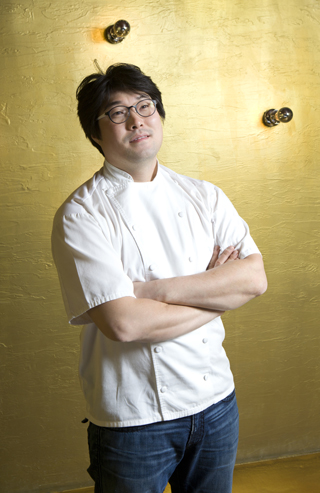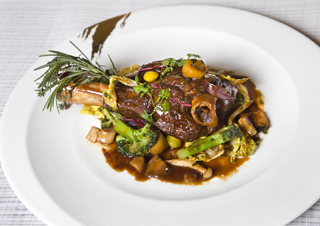Satiation in July: Fusing Korean flavors with French cuisine
Published: 17 Jan. 2012, 20:27

Chef Oh Se-deuk By Park Sang-moon
“Look at all this fat!” Oh said, proceeding to dip a small spoon into a red wine reduction for a quick taste.
“In Europe, there is a saying - never trust a fat chef. In America, the saying goes in reverse - never trust a skinny chef. As you can see, I adhere to the latter saying.”
Wearing a traditional chef’s white double-breasted jacket with faded jeans, the 35-year-old flashed a boyish grin as he said he never sends out a plate without tasting the components of the dish first.
“I’ve never been a picky eater and I try to be as adventurous about tasting different things as I can be,” Oh said during a one-on-one interview with the Korea JoongAng Daily last week. “Food and cooking - creating a dish and it being both beautiful and consumable as well, has always enamored me.”
Oh’s adventurous streak is apparent when looking at this winter’s menu at July, the French restaurant where Oh is currently owner and head chef. The restaurant, which opened in 2007, has fast made a name for itself in the Seoul dining scene with a diverse menu that incorporates ingredients traditionally used in Korean dishes to those found in classic French recipes.
The result is an unusual, eclectic array of foods using fresh, seasonal ingredients from Korea including braised lamb shanks with juniper berries; beef tenderloin with sesame seeds and red wine sauce; white chocolate with bokbunja, or Korean blackberry, sauce and yuzu emulsion.
“I figured, why insist on using all those hard-to-find, Western ingredients? Even if you manage to find them in Seoul, they are all wilted and weak by the time they get imported here.
“Or maybe I was too lazy to seek out all the ingredients!” he said laughing.
Chef Oh’s laid-back demeanor is quite a contrast to his rising reputation as one of the most recognized up-and-coming chefs in the highly competitive local culinary scene.
After graduating from the Institute of Culinary Education in New York in 2002, Oh worked at the Mandarin Oriental Hotel in New York as a line cook before coming back to Korea.
On his experience in the United States, Oh joked, “You’d really have to make an effort to be a bad cook in the U.S. because the country is so abundant with great, inexpensive ingredients.”
Before opening July with two other investors, Oh worked as the head chef of Bistro D, the now defunct brunch restaurant in Apgujeong-dong, southern Seoul.
Last November, Oh was one of four Korean chefs participating in Seoul Gourmet 2011, an annual local culinary festival, alongside Michelin star chefs including Pascal Barbot and Joan Roca.

The chef attributes his career choice to his old girlfriend back in high school.
“I wanted to impress her, so I told her that I would become a world-famous chef one day and that I would cook her the best dishes from around the world. Of course, she is now married to some other guy with two children!”
Still, Oh said his fondest memories about food are still from those days, as a teenager growing up in Korea, eating simple, nutritious food his mother and grandmother cooked for him.
“Whenever I visited my grandmother, she would always cook this steamed chicken dish using some soy sauce. She’d catch and butcher the country chicken herself and it was so simple but because the chicken was fresh, it was so good.”
The chef pointed out that in order for Korean cuisine to successfully go global, chefs have to incorporate Korean ingredients into their menus.
“Koreans tend to spend lavishly on Western food here, but when they see Korean ingredients mixed in with Western recipes, they tend to think it’s not authentic and not worth splurging on,” he said.
“It’s a narrow-minded way to view food. I want to introduce great Korean ingredients and make classic European menus exciting again.”
*Oh Se-deuk’s braised lamb shanks with juniper berries and rosemary
Two Servings Ingredients
Lamb shanks, cut crossways into 2-inch-thick pieces4 pieces
Carrots, diced 2 ounces
Celery, diced 2 ounces
Onions, diced 2 ounces
Juniper berries, crushed 1 tablespoon
Rosemary sprigs, fresh 4 sprigs, plus 2 tablespoons minced
Veal stock 16 fluid ounces
Tomato paste 1 tablespoon
Parsley, minced 2 tablespoons
Canola or vegetable oil
Salt and black pepper
1. Preheat the oven to 400 degrees Fahrenheit.
2. Season the lamb with salt and pepper. Add enough oil to coat the bottom of a rondeau or high-sided skillet. Heat on high, add the meat and saute until they are a rich golden brown, about 3 minutes per side. Remove to a plate.
3. Reduce the heat to medium. If burned, discard the fat and add 3 tablespoons of oil. Immediately add the celery, carrots, onions and juniper berries. Saute until lightly brown for five to seven minutes. Add more oil if necessary to keep the vegetables from burning.
4. Add the wine and deglaze the pan by scraping the bottom with a wooden spoon. Bring to a boil, remove from the heat and add the rosemary sprigs, veal stock and tomato paste. Place the lamb on top of the vegetables (the liquid should come halfway up the lamb), cover and place in the oven.
Cook until the lamb is tender (turning it once) for approximately two-and-a-half to three hours.
5. Using tongs, transfer the meat to a heated platter and cover loosely with aluminum foil while finishing the sauce.
6. Strain the cooking liquid and vegetables through a fine-mesh strainer. Press down on the vegetables to extract all the juices. Return the juices to the pan and reduce by half, skimming the surface carefully with a ladle. Cook until the color becomes a deep dark brown and the sauce is thick enough to coat the back of a spoon, for about ten minutes. Stir in the minced rosemary and parsley. Adjust the seasoning with salt and pepper. Return the lamb to the skillet and coat with the sauce.
**Fresh Chops is a series about up-andcoming chefs in Korea under 40 years old who are changing the culinary scene in new and exciting ways.
By Cho Jae-eun [jainnie@joongang.co.kr]










with the Korea JoongAng Daily
To write comments, please log in to one of the accounts.
Standards Board Policy (0/250자)